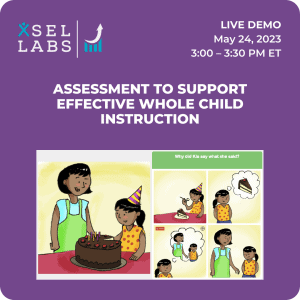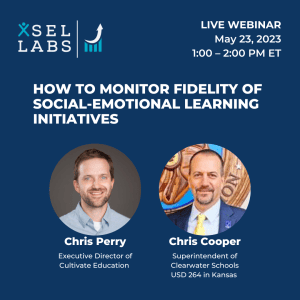Knowing And Doing: Assessing and Addressing Both
Knowing what to do and following through with it are not always the same. This truism applies just as much to social and emotional learning as to other areas of life.
Imagine, for example, a fourth-grade student who has a disagreement with a classmate. The student becomes frustrated and says something hurtful to the classmate, and the disagreement is not resolved. After the fact, the teacher talks with the student, who can explain the problem, describe the classmate’s point of view and describe several ways they could have peacefully resolved the disagreement.
The student knew what to do but did not do it. Ever met a student like this? Ever been that person?
Assessing What Students Know and What They Do
What do these students look like in districts that use SELweb, our direct assessment, which measures children’s ability to read social cues, solve social problems, and manage their emotions? They do well on SELweb but display problem behaviors—infrequent positive or frequent disruptive behavior. Our partners find this pattern puzzling. When we talk about these students, they sound like the student we introduced above: After misbehavior, they can describe what was happening, understand others’ perspectives, and know what they should have done. What they understood was not the same as what they did.
SELweb measures what students know and understand about others, about challenging situations, and how to manage emotions. Overall, better performance on SELweb is associated with more positive behavior and less problem behavior. But behavior is what students do with what they know. And sometimes, as we have been discussing, what students know and what they do are not the same.
Assessing what students know with SELweb and considering what students do can help educators make fully-informed decisions about how best to support students. The table below helps sort what to do depending on what students understand and what they do. In the table, we describe whether they score low on SELweb and whether they display challenging behavior. Note that most students fall in the upper left corner—in which they neither score low on SELweb nor display challenging behavior. For those students no action is needed beyond the Tier I support provided to everyone.
| Displays Challenging Behavior? | |||
| No | Yes | ||
| Scores low on SELweb? | No | No action needed beyond Tier I supports. | Support execution of skills. |
| Yes | Investigate further. | Teach social and emotional competencies. | |
Working with Students Who Know but Have Difficulty Executing
Students in the upper right corner are our puzzling students—they perform well on SELweb but also display challenging behavior. A reasonable start-point for those students is to assume, like the student we introduced earlier, that those students know how to read social cues and know what they should do, so teaching them those basic skills may not yield a benefit.
Instead, those students need support to execute those skills in their daily interactions. What might that look like? In other words, what can educators do to increase desirable behaviors and decrease problem behaviors?
Dennis Embry from the PAXIS Institute and Anthony Biglan from the Oregon Research Institute wrote a wonderful article summarizing more than 50 evidence-based strategies for influencing student behavior. Because the strategies they describe are simple practices, not complex programs, they call them “evidence-based kernels.” You can consider evidence-based kernels in this article as a menu of simple, practical, and effective approaches to supporting the execution of social and emotional skills. Sample evidence-based kernels are in the table below.
Goal | Sample Kernel | Description |
| Increase frequency of desired behavior | Verbal praise | Provide positive verbal recognition when student engages in desired behavior. |
| Team competition | Assign groups of students to teams and set a clear behavioral expectation for the group and award points to groups based on execution of behavior. | |
| Decrease the frequency of unwanted behavior | Daily report card | Send positive note home when child refrains from target behavior. |
| Private corrective feedback (Mikami et al (2013)) | Provide brief low-emotion corrective feedback to child privately when possible to reduce stigma. | |
| Alter physiological response to stressor for self-regulation | Turtle | When upset, child hugs self, takes deep breath through nose, and sub-vocalizes calming self-talk. May be done with or without adult praise/reinforcement. |
When executed correctly and consistently, these (and 49 other kernels in the Embry and Biglan paper) can support children with execution challenges by increasing the frequency of desired behaviors, decreasing the frequency of unwanted behaviors, and helping the child manage strong emotions.
Kernels may be simple, but that does not necessarily mean they are easy. Speaking as someone who has used behavioral strategies in my work, though they are simple in principle, using these kernels consistently and effectively takes a little bit of practice. In addition, they are not magical, one-use solutions. It is the consistent and effective use of these strategies that leads to enduring behavior change.
Working with Students Who Do Not (Yet) Know
So far, we have focused on students who do well on SELweb but have behavioral challenges. The more common case, however, is that children with execution challenges also have difficulty either reading social cues, solving social problems, managing emotions, or some combination of those skills. For these children, behavioral challenges are often, at least in part, because they misread social cues, do not have effective ways to navigate social challenges, and/or become overwhelmed and dysregulated. These children may benefit from focused instruction to help them learn these basic skills. Several promising or proven strategies for teaching these skills include:
- Skill-specific direct instruction focused on social problem-solving skills, social thinking skills, and mindfulness.
- Literacy interventions that incorporate social and emotional content, such as Rosen Publishing’s Focus on Social and Emotional Learning.
- Teaching (or re-teaching) specific lessons from a Tier I SEL curriculum.
- Programs designed to teach SEL skills to students who need extra help, including BASE and SSIS-CIP.
Working with Students Who Are Doing Fine
When students are, by all indications, doing fine–they positively interact with peers and adults, are engaged in activities, and otherwise appear to be successfully navigating the many moments that make up the day, no additional support is needed beyond Tier I SEL supports. It is important to note that this is true, whether a child scores well on SELweb or not. That is because, in rare cases, students score low on one or more SELweb subtests but display no other indications of challenge. As with all assessments, SELweb provides a single data point, and corroborating information is important before making strong conclusions, particularly conclusions about individual students’ areas of extra need.
Bottom Line
Assessment can and should help guide Tier I instructional decision-making. For students who need extra support, assessment can help sort out whether their challenge is knowing how to understand and respond to social challenges or putting that knowledge into practice. Knowing the difference can, in turn, help educators decide whether to focus on teaching the wisdom that underlies social skills or teaching students to generalize that knowledge into their everyday behavior.



